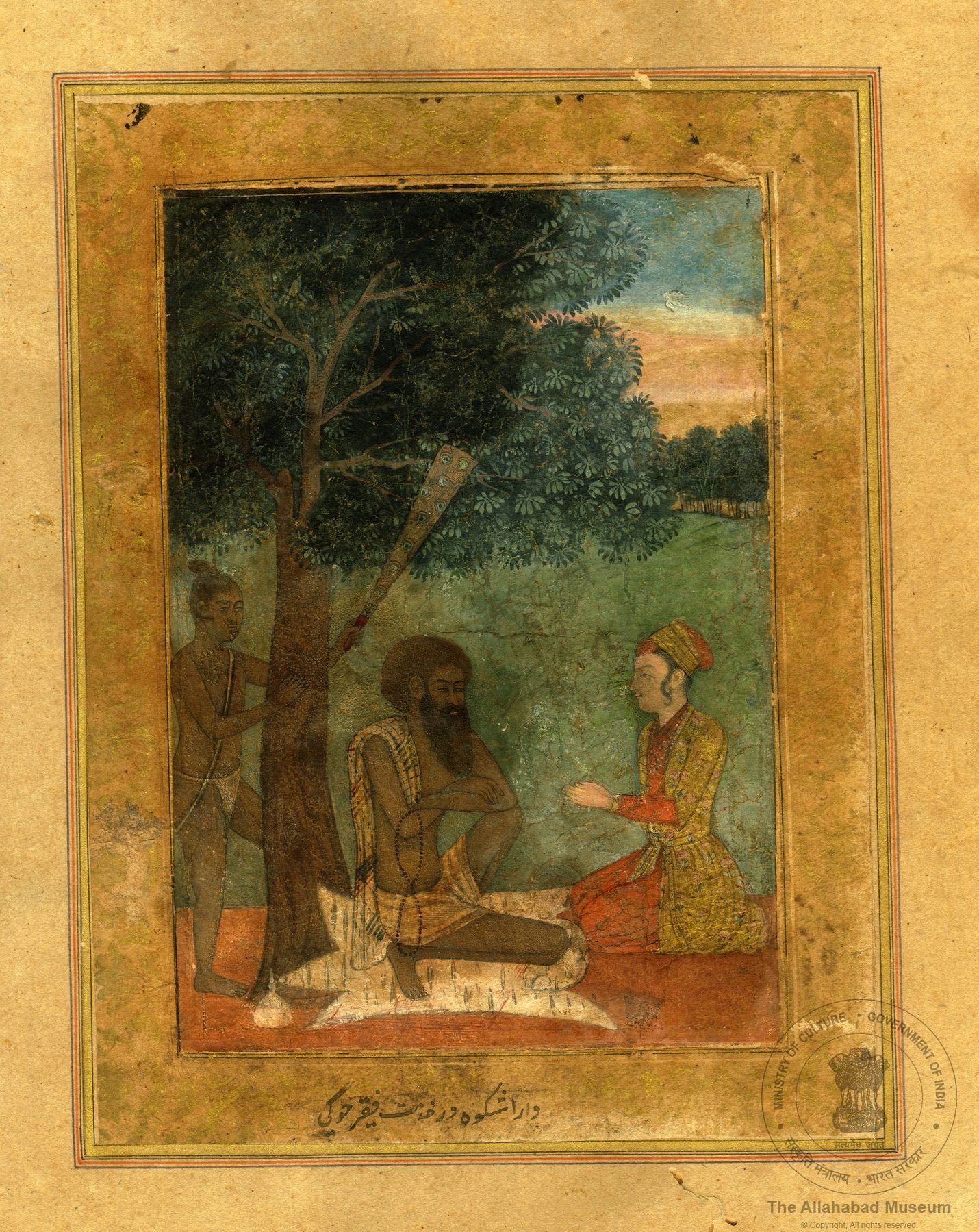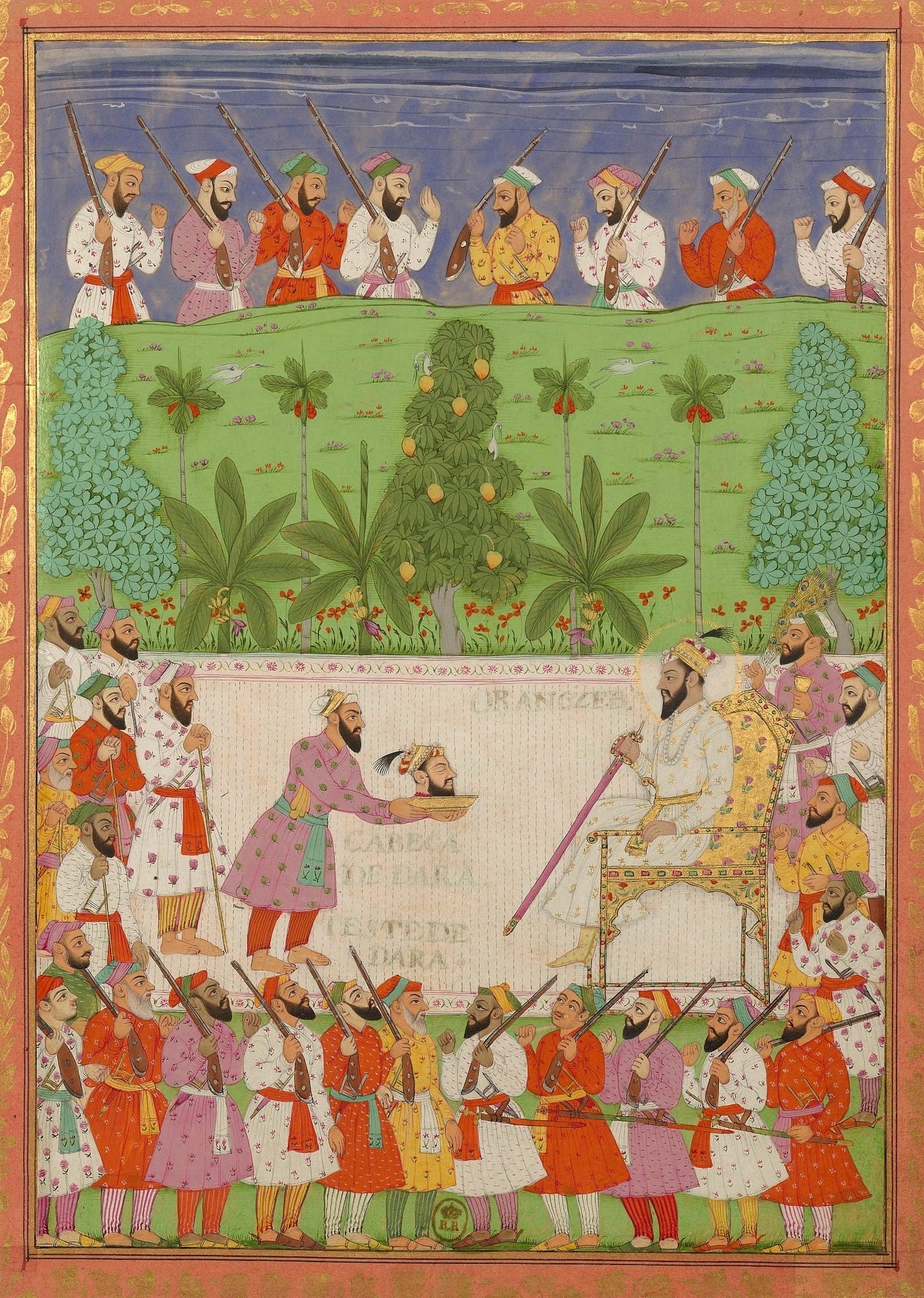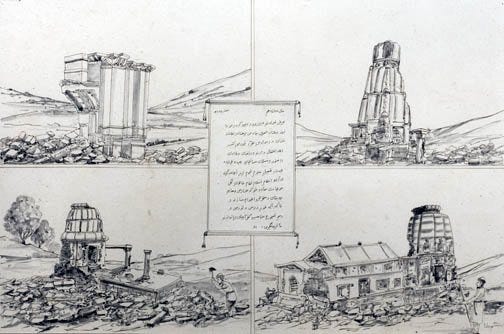Aurangzeb's Destruction of Hindu Temples
Aurangzeb would have blitzkrieg-ed through Hindu temples if he had the technology
Those who do not learn from history are forced to repeat it. And those who do not allow others to learn from history, ensure that others repeat it (while they reap the benefits).
The unique quality of a tyrannical regime is that even though a plethora of texts exist to document it, apologists of the tyranny always find one way or another to justify the tyranny, for their own vested interests, and often bigotry.
This article is an investigation into attempts at revisionism of Hindu history of the Indian subcontinent in general, and destruction of Kashi Vishwanath Temple by Aurangzeb in particular.
No Room For Revisionism
In the face of incontrovertible historical evidence of an autocratic, state sponsored persecution of the masses in the Indian subcontinent during the Islamic rule, those who attempt to find the mythical “silver lining” are revisionists, for whom nothing will ever be tyrannical enough to be labelled as such. These poetic accounts which gloss over gut wrenching brutalities don’t just do an injustice to the millions who were slaughtered or tortured in horrifying ways, nor just to the survivors, but to all of humanity, because they verily try to convince us that these sympathizers of persecutors still live and walk among us, and have a seat at the table where decisions are made. If one can justify horrifying crimes against one ethnic group, justifying crimes against another ethnic group is only a short walk from there. Justification of past brutalities is the cleanest way to pave the way for a repeat of the past. History has not taught us anything if it has not taught us that. And if it has not taught this to someone, that person cannot truly claim to be a historian, because the very idea of studying history is lost on that person.
Although Audrey Truschke is the leading voice in this revisionism, there is a burgeoning “scholar” class that is continuing her line of work, and truth is now getting lost in a zig-zag web of lies and propaganda. So let’s understand Aurangzeb—the man, the myth—once again, with facts.
Hindu Temples Were Destroyed by Every Islamist Ruler
Aurangzeb’s destruction of Hindu temples was not an aberration of any kind—neither in his behavior, nor in the behavior of the Islamist rulers. He was continuing the legacy of the previous kings, sometimes fulfilling tasks which his ancestors had hitherto failed in. Any Islamic king who did not follow this pattern of destruction of Hindu culture was extirpated by his extremist brethren, and the throne was thus always in the hands of an extremist ruler.

A prominent example for this is the Prince Dara Shikoh, the eldest son of Shah Jahan and the rightful inheritor of the throne, who attempted to learn and popularize Hindu sacred texts, but was brutally beheaded on the instruction of Aurangzeb, with his severed head presented to Aurangzeb in the royal court after usurpation of the throne by Aurangzeb. The corpse of Dara Shikoh was mounted on an elephant and paraded in the city of Delhi, to strike terror in the hearts of citizens. Thus, to be a king, you had to be an extremist during the Mughal era. A non-extremist king could not retain the throne. As such, every ruling king was an extremist, and took proactive measures towards destruction of Hindu culture, places of worship and to demean the position of Hindus in the society.

Aurangzeb’s Mass Destruction of Temples
Aurangzeb’s intolerance towards non-believers can be gauged from the fact that he called upon scores of Islamic scholars to compile a text called Fatawa-i-Alamgiri, which documents a detailed list of Fatawas in 30 volumes. A “fatawa” is an injunction which bans “infidels” from certain practices, and/or applies special laws, taxes and/ or punishments on them. This book was a working manual for Aurangzeb’s courtiers and soldiers.
Another text, Maasir-i-Alamgiri, documents the injunctions issued by and other acts of Aurangzeb by his courtiers.
In line with his policy, Aurangzeb issued numerous orders for destruction of Hindu temples, and was often present in the city to get reports of the destruction. The Islamic kings rarely stepped out of their palaces to perform these tasks themselves, as they believed their status was way above normal soldiers and courtiers, and these were menial, everyday tasks. The king’s status was higher than just the head of the state. As depicted in numerous paintings of the 17th and 18th century, he was to be revered as someone with godly powers, and had a “halo” around his head to signify that. Since destruction of temples was a task carried out ever so often, it was not the job of the king to carry it out himself, but merely to send his army to fulfill the deed.
An example of an injunction that captures Aurangzeb's sentiment towards Hindu temples and schools, in his own words, documented by his courtiers:
9th April 1669
“The Lord Cherisher of the Faith learnt that in the provinces of Thatta, Multan and especially at Benaras, the Brahmin misbelievers used to teach their false books in their established schools, and their admirers and students, both Hindu and Muslim, used to come from great distances to these misguided men in order to acquire their vile learning. His Majesty, eager to establish Islam, issued orders to the governors of all the provinces to demolish the schools and Temples of the infidels, and, with the utmost urgency, put down the teaching and the public practice of the religion of these unbelievers.”Maasir-i-Alamgiri, p. 81, Tr. J.N. Sarkar
Source: http://www.aurangzeb.info/
These are some of the specific incidents of destruction of Hindu temples:
January-February 1680: ‘The grand temple in front of the Maharana’s mansion (at Udaipur) – one of the wonderful buildings of the age, which had cost the infidels much money – was destroyed and its images broken.’
‘On 24 January the Emperor went to view the lake Udaisagar and ordered all the three temples on its banks to be pulled down.’
‘On 29 January Hasan Ali Khan reported that 172 other temples in the environs of Udaipur had been demolished.’
‘On 22 February the Emperor went to look at Chitor, and by his order the 63 temples of the place were destroyed.’
10 August 1680: ‘Abu Turab returned to Court and reported that he had pulled down 66 temples in Amber.’
2 August 1680: ‘Temple of Someshwar in western Mewar ordered to be destroyed.’
September 1687: ‘On the capture of Golkonda, the Emperor appointed Abdur Rahim Khan as Censor of the city of Haidarabad with orders to put down infidel practices and (heretical) innovations and destroy the temples and build mosques on their sites.’
—Akhbarat. Jadunath Sarkar, History of Aurangzeb, Volume III, Orient Longman, New Delhi, 1972 reprint, pp. 185–89., quoted from Shourie, Arun (2014).
Source: https://ru.citaty.net/tsitaty/1880397-aurangzeb-the-emperor-ordered-jumdat-ul-mulk-to-write-to-the/

It is well-documented by the courtiers of Aurangzeb that they built mosques after destroying Hindu temples, and were rewarded for the same:
Middle of 1698: ‘Hamid-ud-din Khan Bahadur who had been deputed to destroy the temple of Bijapur and build a mosque (there), returned to Court after carrying the order out and was praised by the Emperor.’
Akhbarat. Jadunath Sarkar, History of Aurangzeb, Volume III, Orient Longman, New Delhi, 1972 reprint, pp. 185–89., quoted from Shourie, Arun (2014).
Source: https://ru.citaty.net/tsitaty/1880397-aurangzeb-the-emperor-ordered-jumdat-ul-mulk-to-write-to-the/
The soldiers slayed or captured anyone who resisted as a prisoner, when the destruction of the temples was carried out:
“…Saiyad Faulad Khan has reported that in compliance with the orders, beldars were sent to demolish the Kalka Temple which task they have done. During the course of the demolition, a Brahmin drew out a sword, killed a bystander and then turned back and attacked the Saiyad also, inflicting three wounds. The Saiyid managed to catch hold of the Brahmin.”
Siyah Akhbarat-i-Darbar-i-Mu‘alla, Julus 10, Rabi II, 3 / 12 September 1667.
Source: https://ru.citaty.net/tsitaty/1880397-aurangzeb-the-emperor-ordered-jumdat-ul-mulk-to-write-to-the/
These are only a few examples from voluminous texts. It is unbelievable that someone would study the life and achievements of Aurangzeb without reading this text. It is also worth noting that while Audrey Truschke eulogizes Aurangzeb, his brother, Dara Shikoh, is mentioned as “blood thirsty”. If her intention is to promote tolerance, she should have captured the tolerant acts of Dara Shikoh as well. The only possible reason why someone can omit these facts from their work on the ruler is that they do not want to include it. There is no other acceptable reason.
Audrey Truschke’s False Claims on Destruction of Temples
Audrey Truschke (AT) has made several claims in her book “Aurangzeb—The Man, The Myth,” in the chapter, subsection “Destroyer of Temples” (p 106-113). I have not found any evidence to prop up her claims. Au contraire, I have found plentiful evidence that shows how flawed and contradictory her claims are.
AT writes:
“Of the tens of thousands of Hindu and Jain temples located within Mughal domains, most, although not all, still stood at the end of Aurangzeb’s reign.”
In the very next line, she goes on to contradict her own self, quite laughably:
“Nobody knows the exact number of temples demolished or pillaged on Aurangzeb’s orders, and we never will.”
It is astounding how she can make these two claims in two consecutive lines, and not see the inherent contradiction in them. If AT does not know how many temples were demolished, and, as she claims, nobody ever will, how can she conclude that “most if not all” temples were intact at the end of Aurangzeb’s reign?
She mentions the work of a scholar Richard Eaton as a “leading authority on the subject”—as per whom? Who made Eaton the leading authority? Is this much the same way as AT claims her own self to be the leading authority on everything? The same scholar Eaton states that Aurangzeb destroyed a maximum of a dozen temples, without any evidence to back up his claim! The same scholar did not even count the demolition of Somanatha temple in his works (as mentioned by AT herself a few lines later). How can such a person be a leading authority on the subject, when he does not even count the most prominent and sacred Hindu temples in his work? There is absolutely no evidence for this claim.
As will be evident from the references given previously, Aurangzeb destroyed almost all temples in certain cities, totalling to several hundreds of temples, if not thousands. But the work Maasir-i-Alamgiri, which is documented at the time of Aurangzeb’s reign, at his orders, without any adulteration or opinion from any external person, is mentioned as an “exaggeration” by AT in her book. Once again, there is no evidence or reasoning to back up this claim that the work is an exaggeration, especially since all the temples mentioned as destroyed in the book were actually destroyed, and we can see that with our own eyes in numerous places.
“It is worthy of notice as indicative of the nature of Mahomedan rule in India, that nearly all the buildings in acknowledged antiquity have been appropriated by the Mussalmans, being used as mosques, mausoleums, dargahs, and so forth, and also that a large portion of the separate pillars, architraves, and various other ancient remains, which, as before remarked, are so plentifully found in one part of the city, are contributing to the support or adornment of their edifices. Not content with destroying temples and mutilating idols with all the zeal of fanatics, they fixed their greedy eyes on whatever object was suited to their own purposes, and without remorse or any of the tenderness shown by the present rulers, seized upon it for themselves.”—Benares, Past and Present. India, Printed at the Metropolitan Press, 1865, p 9-10.
Then it goes on to recount how very few temples in the ancient city are of recent origin, as most of the temples were destroyed by the Mohammedans:
“When we endeavour to ascertain what the Mahomedans have left to the Hindus of their ancient buildings in Benares, we are startled at the result of our investigations. Although the city is bestrewn with temples in every direction, in some places very thickly, yet it would be difficult we believe to find twenty temples in all Benares of the age of Aurungzebe. The same unequal proportion of old temples as compared with new is visible throughout the whole of Northern India. Moreover the diminutive size of nearly all the temples which exist, is another powerful testimony to the stringency of the Mohamedan rule. It seems clear that for the most part the emperor forbade the Hindus to build spacious temples, and only suffered them to erect small structures of the size of cages for their idols, and these of no pretensions to beauty.”
—Benares, Past and Present. India, Printed at the Metropolitan Press, 1865, p 9-10.
Many Hindu temples, which are too sacred to Hindus, were destroyed multiple times because every time the temple was destroyed, it was rebuilt by a Hindu king. Wherever possible the Hindu sanyasis (monks) and soldiers put up a tough fight, and the army of the rulers failed in their task in the face of tough Hindu resistance. Much of this has already been documented. But, as per AT, since two orders were issued to destroy the Somanatha temple, one in 1659 and the next in 1706, it must mean that “the existence of a second order suggests that the first was never carried out.” This conclusion has no basis, especially since the resistance of Hindu monks and kings to the onslaught of Mughal invaders is fully documented in Maasir-i-Alamgiri itself, and also noted by later scholars. The first onslaught was thwarted. But AT prefers to assume, for no obvious reason, that it was not carried out by Aurangzeb.
One of the other argument that is consistently presented by AT is that Aurangzeb destroyed temples because they were centers of political power. Yet, it defeats the imagination as to how hundreds of temples—in a city which has temples in every nook and cranny—can be “centers of political power.” Was the king ruling from all those hundreds of temples? Obviously not. Then why were so many temples wiped out from these cities? Another historian, documents and illustrates with a sketch thus:
“No. 33.-Mosque of Aurungrebe. The Jumna Musjid, a fine and majestic building, was erected by the intolerant and bigoted Aurungzebe, immediately after his conquest of Benares; with the materials, and on the site, of one of the most holy temples, dedicated to Mahâdeve, which he had destroyed for the purpose. It is a conspicuous building, standing on a commanding point it has very little ornament, and in some parts appears never to have been finished. The slender and beautiful minarets which tower with proud superiority land; above the surrounding pagodas, are said to be 232 feet in height. In order to mortify the Hindoos, Aurungzebe, with the meanness of a narrow and bigoted mind, caused his licentious soldiers daily to ascend the roof of the Mosque, to gaze into the interior courts of the houses, and at the bathers at the sacred ghauts, thus cruelly invading their privacy, and interrupting their daily devotions, which the proud conqueror took every opportunity of making the object of his ridicule.”
—Burford, Robert. Description of a View of the Holy City of Benares, and the Sacred Ganges: Now Exhibiting at the Panorama, Leicester Square. United Kingdom, Brettell, 1859, p 12.
This explains the motives of Aurangzeb in a more insightful way than AT would have it. Yet, it offers an explanation of why so many temples were destroyed in entirety—to ridicule and dehumanize Hindus.
Why Do We Still Have Aurangzebean Apologists?
Germans and Christians don’t identify with Nazis. Nor do Austrians identify with Hitler. Why should they? They are clear that they do not subscribe to whatever ideology led Hitler to carry out such horrendous acts against a group of people. Just because some people belong to the same race (by birth), or are co-religionists, does not automatically mean that they belong to same ideology. Personal choices matter. Nor do scholars justify acts of Hitler due to his troubled past or the defeat of Germans in World War 1. Why would they? No political conflict can justify destruction of the cultural heritage of a group of people, threatening their very existence.
Yet, many prominent Muslim journalists in India repeatedly justify acts of Aurangzeb and his predecessors, and are even incensed when his name is pulled off from a road. There are scholars like Audrey Truschke and Richard Eaton who attribute the inhuman acts of Aurangzeb to “political conflict.”
Recently, when a court orders the excavation of a Hindu temple site, prominent journalist Rana Ayyub makes the issue about all Muslims, rather than seeing it as the salvaging of a historic wrong carried out by Aurangzeb. She has the gall to talk about “humiliation” of all Muslims, rather than seeing it as the rectification of an action that should do Muslims proud. No German would want perpetuation of concentration camps or gas chambers. By the same logic, these Muslims should not object to investigation of sites that saw Hindu massacres. Considering how much Hindu blood was spilled when the Hindu temples were razed to the ground, there should not be any reason to object to excavation of the site—mere excavation of the site to establish facts about history which has been smeared with agenda. Moreover, any Muslims who do step forward to support the move get demonized by the same personalities.
Aurangzeb’s legacy was blood and tears for anyone who disagreed with him or disobeyed him. He was an extremist leader, who did not even spare his own kinsman in his greed for the throne, and his religious fanaticism. To support him is to identify with the same fanaticism. To want to carry forward his legacy is to perpetuate the bigotry which committed genocides against Hindus.
In the next article, I will take a deep dive into the real history of the Kashi Vishwanath Temple, and the trail of events that have led to the PIL and court order for excavation of the site. Subscribe to the publication to get previews of my upcoming book, and get nuggets of real Hindu history:
This article is a mere preview of the type of work that remains to be done in a book to counter the copious lies of AT and her cabal.
This one article alone references at least 7 books and numerous websites, all of which I studied in my own individual capacity. On the other hand, Audrey Truschke does the work of concocting history on the payroll of a university, with institutional support and immunity. If you would like to see me successful in my work of bringing out real history, do consider supporting me on my fundraiser. You can contribute from anywhere in the world.




